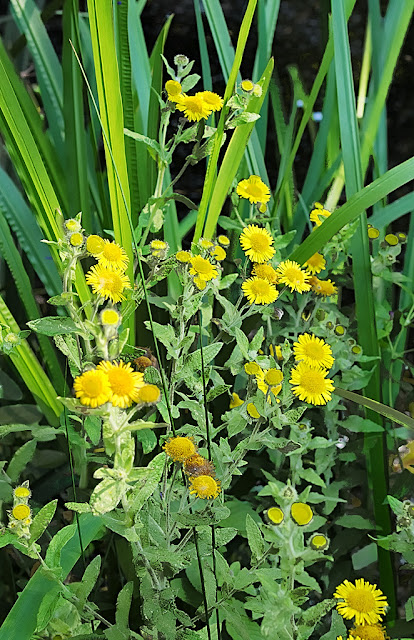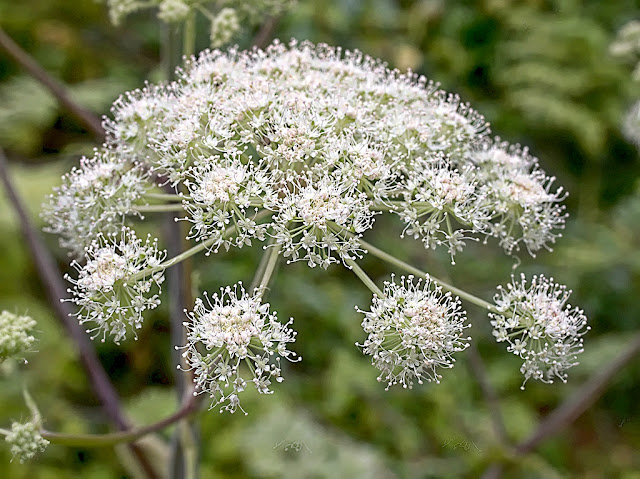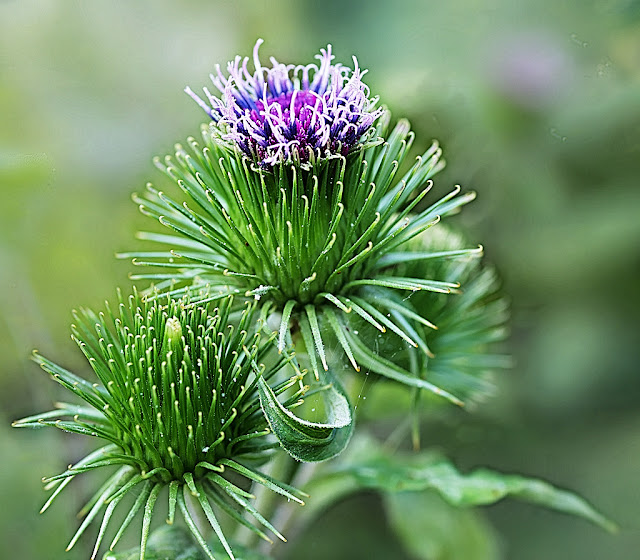As
summer draws on, there is less and less colour in Milton Country
Park; the flowers that are out tend to be reasonably inconspicuous
and occurring in small isolated clumps.
 |
| Tansy - 7 August 2016 This is the single clump in the whole park |
Tansy
One
such flower is tansy. There is a single, and very prominent, clump of
its bright yellow flowers next to one of the paths in the north of
the park. It is not only decorative, but useful in companion
planting for biological pest control: for instance, growing tansy
next to potatoes protects them from potato beetle. In the domestic
environment, planted around your dustbins it will repel mosquito,
ants and flies. It dried flowers will also serve the same purpose.
Historically,
has been used both to induce abortions and, paradoxically, to help
conceive and prevent miscarriages. Other uses included treatment for
worms, fevers, and flatulence. But it is basically toxic, and its
medical use is now largely discredited.
Common Fleabane
 |
|
Another
insect repellent to be found amongst the reeds at the edge of the
lakes in the park is common fleabane. It is so named because its
scent repels insects, and was kept in the house specifically to repel
fleas.
Great Hairy Willowherb
 |
| Great Hairy Willowherb - 3 August 2016 Its bruised leaves are said to smell of codlins and cream |
Another plant to be found in isolated clumps around the lakes is the great hairy willowherb, not to be confused with the rosebay willowherb and purple loosestrife which occupy the same habitat. The plant shown here was by the jetty on Dickerson's pit, and catching the last rays of the evening sun.
Apparently,
and I haven't tried it, when lightly bruised the leaves, and
particularly the top shoots have the smell of scolded codlings. This
has given rise to a number of alternative names including: codlings
and cream, apple pie, cherry pie, gooseberry pie, and sod apple and
plum pudding.
Water Figwort
 |
| Water Figwort - 10 July 2016 A plant for tooth ache and nightmares |
Yet
another plant of the water margins, but a very inconspicuous one. I
only found a couple of plants by the small inlet at the north-west
corner of Dickerson's Pit, while looking at the reeds.
The
origin of the name of figwort is interesting. One source states it
is derived from its use according the doctrine of signatures to treat
the disease ficus, which is apparently a synonym for haemorrhoids.
A second source suggests its name comes from the shape of its root!
It
has previously been used as a herbal remedy for ailments as diverse
as toothache and nightmares; and is still used in the treatment of
wounds.
Hogweed
 |
| Hogweed - 14 August 2016 Early in the morning and the flies that are usually to be found on it are not yet awake |
There
are few plants of hogweed in the park, but those that are there are
very obvious. This picture was taken in the early morning before the hoards of flies and hoverflies come looking for its nectar are awake.
Opinion seems divided as to the derivation of the name: it is alternatively given as either the flower smelling of pigs, or the love of pigs for its roots.
Burdock
 | |
| Burdock - 31 July 2016 Its stiff hooks, the inspiration for velcro, are clearly visible |
In
contrast to the other flowers here, burdock is abundant right across
the park. It has two claims to fame. Firstly, its roots are use to
make dandelion and burdock cordial. Secondly, the stiff hooks and
its flowers and seed heads, which gave rise to its alternative names
of beggar's buttons and clingers, were the inspiration for velcro.
Links
Water FigwortTansy
Great Willowherb
Common Fleabane
Hogweed
Burdock
For information on names, I also consulted the book 'On the Popular Names of British Plants' by R.C.A. Prior
Next: Apples and Plums
Common Fleabane
Hogweed
Burdock
For information on names, I also consulted the book 'On the Popular Names of British Plants' by R.C.A. Prior
Next: Apples and Plums
No comments:
Post a Comment